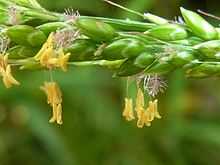Setaria megaphylla
| Setaria megaphylla | |
|---|---|
 | |
| | |
| Scientific classification | |
| Kingdom: | Plantae |
| (unranked): | Angiosperms |
| (unranked): | Monocots |
| (unranked): | Commelinids |
| Order: | Poales |
| Family: | Poaceae |
| Genus: | Setaria |
| Species: | S. megaphylla |
| Binomial name | |
| Setaria megaphylla (Steud.) T.Dur. & Schinz | |
| Synonyms[1] | |
| |
Setaria megaphylla, the broad-leaved bristle grass, big-leaf bristle grass, or ribbon bristle grass,[2] is native to south-eastern Africa.[3] It is also cultivated, and it has naturalized outside its native range, for example, in Florida in the United States.[2]
It may be found in glades in forested areas and along rivers or streams. It can grow to more than 2 metres tall and has broad dark green leaves and hairy leaf sheaths. Many kinds of birds, such as finches and canaries, eat the seeds.[4]
References
- ↑ "The Plant List: A Working List of All Plant Species". Retrieved 14 December 2014.
- ↑ 2.0 2.1 Setaria megaphylla. Germplasm Resources Information Network (GRIN).
- ↑ van Oudtshoorn, F. (1992). Guide to Grasses of South Africa. ISBN 0-620-16539-1.
- ↑ Setaria megaphylla. South African National Biodiversity Institute.